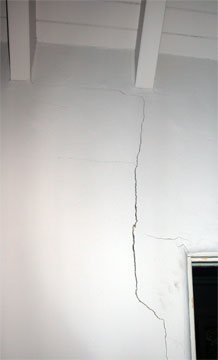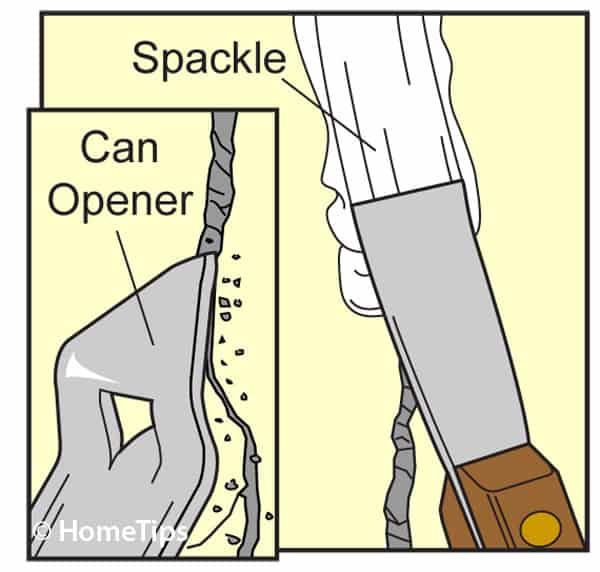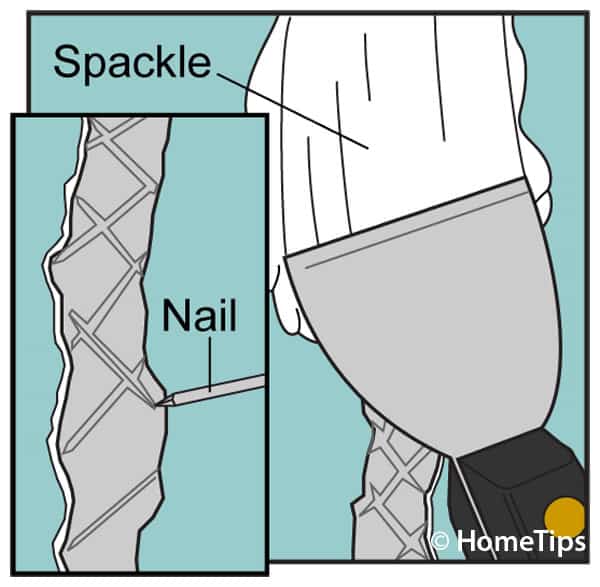How To Repair A Heavily Damaged Plaster Boarded Wall
Expert advice and detailed instructions on repairing the virtually common plaster wall and ceiling problems, including cracks, holes, and sagging
Plaster practical to woods board is held in place by the "keys" that form when it squishes through the lath. (For more nearly how plaster walls are built, see Plaster Wall Construction.) Over fourth dimension, these keys can disintegrate, causing the plaster to crack, crumble, and fall away from the lath. Settling of a firm or the occasional earthquake tin speed this process.

Some plaster is of poor quality, and this may crusade the plaster to crack and crumble. In add-on, water damage from roof or plumbing leaks can discolor plaster and crusade peeling or efflorescence, the leaching of salts and minerals to the surface.
Plaster can as well be damaged from the normal stresses and strains of people living in a house: holes from wall hangings, scratches from article of furniture, spilled liquids. Fortunately, most of these unproblematic problems tin be easily fixed.
Cracks leading from windows and doors or forth seams in the ceiling can signal more significant impairment, so y'all may desire to call in a contractor to accept a expect at your abode's structural integrity.
Repairing Pocket-size Cracks in Plaster
Small cracks in plaster are relatively easy to repair, with one condition: The plaster must be firmly anchored to the lath backside information technology. If, when you push button on the wall, it flexes as though information technology has broken away from its support base, telephone call a plaster specialist—the repair volition involve removing the loose plaster and replacing it.
Information technology merely takes a little spackling compound to repair fine cracks, boom holes, and gouges in a firmly anchored plaster wall. Here'south how:
1 Widen the crack. Wearing safety glasses, have a lever-type can opener and use the point to widen the crack to about 1/eight inch, every bit shown at right. Or, you can utilise a screwdriver or a utility knife.

2 Blow out the plaster dust. Using a medium-bristle brush, scrub the area with a solution of water and tri-sodium phosphate (TSP) or a not-phosphate detergent.
3 Cut brusque pieces of cocky-agglutinative fiberglass mesh joint tape and cover the groove with them.
4 Dip a sponge in clean water and dampen the area of the repair.
5 Mix setting-type joint chemical compound and employ it over the tape and groove using a 3-inch-wide putty knife. Smooth it out evenly and allow it to dry.
half-dozen Utilise some other glaze of joint compound with a drywall pocketknife or wide-blade putty knife. Apply information technology smoothly and "feather" the edges then that they taper into the undamaged surface area. Allow the compound to dry and so sand lightly to blend the patch into the wall at the edges.
seven Prime with a loftier-quality latex primer and then pigment.
Repairing Large Cracks in Plaster
Larger cracks can be fixed in a similar way:
ane Widen the crack with the tin can opener and dampen the edges of the fissure with a sponge.

2 Fill the cleft half full with patching plaster. When it has dried a picayune, score the plaster with a nail, as shown at right. This volition give the next layer of plaster something to agree onto.
three Dampen the patch again and employ another layer of patching plaster to about one/iv inch of the surface. Let the patch dry and apply a glaze of finishing plaster.
Repairing Holes in Plaster
It's relatively easy to repair small holes in plaster if the lath backing that grips the plaster is intact. If the lath bankroll is fine, you can mix joint chemical compound with plaster of Paris for the patch.
Outset brush abroad loose plaster and dust. Working from the edges inwards, push button the plaster mixture into and through the lath for a adept bond. Apply an initial "scratch" coat. Let this dry out, so apply a finish glaze.
If there isn't proper bankroll behind the hole, install backing commencement. Begin by enlarging the hole just plenty to expose firm lath around the perimeter. Using tin can snips, cutting a piece of wire mesh that's big enough to bunch-up and fill the opening when you push information technology into the hole. If necessary, wind wire ties wound effectually one or ii dowels or sticks to hold information technology in identify until the plaster mixture hardens.
Apply the plaster mixture in layers, allowing each to set before applying the next. When the patch is complete, and dry, simply snip off the exposed wire.
Getting the surface coat smoothen tin exist tricky, particularly if the hole is large and you have express plastering skills. In this instance, use only joint compound for the concluding glaze. When the patch is dry, utilize fine sandpaper to sand the surface smoothen. Then prime and paint it to friction match the wall.
How to Ready Sagging Plaster
Flaking and cracking plaster are relatively minor repair items, only when the plaster starts to sag, or "belly out," from a wall or ceiling, information technology indicates deeper bug.
Plaster is heavy, and it needs a solid, well-anchored base to support its weight. This base is ordinarily strips of woods or metal wire mesh (both referred to as board) that are nailed to the wall and ceiling framing. When the plaster is applied, information technology squeezes through the lath, creating "keys" that harden to grade a stiff integral bail with the wall.
Over the years, plaster can dry out and lose its belongings force, or weaken from vibration, and the keys begin to intermission abroad. The board can besides pull away from the framing. Gravity and the weight of the plaster exert themselves, and the first sign is often sagging, followed eventually by the collapse of the plaster surface.
At this point, you may want to call in a professional. Repairing a big wall area is hard enough, but if the ceiling is first to sag, working over your head with heavy, hard-to-handle materials is non an easy job. If you still want to effort your own repairs, hither'due south how:
1 Commencement, protect the floor under your work area, because one time you begin the entire affected area could give way. To prevent plaster dust from spreading into the rest of the house, hang clammy sheets or record plastic sheeting over the doorways and put an exhaust fan in a window. If y'all're worried that much of the ceiling could come up down at once, build T-shaped supports from 2 by 4s and utilize them to concur a piece of plywood flat against the ceiling while yous piece of work.
ii Use a hammer and cold chisel or wrecking bar to scrap out a small area at the border of the bulge (habiliment safety spectacles). Once you tin come across backside the surface, yous should be able to tell if the plaster has pulled away from the lath or the board itself has come loose from the framing. If the lath has pulled away and the plaster is still well-adhered to it, you may be able to refasten the lath to the framing without removing the plaster.
3 Utilize long drywall screws that will penetrate at least half their length into the woods framing. Showtime virtually the edge of the burl and press the ceiling upward equally you bulldoze the screws (you may have to shift your plywood back up, and the tees holding it, equally you work). Because the plaster and lath grade an integral sheet, like a piece of drywall, information technology may become dorsum upwards without a trouble. Still, if the board has warped, or if the one-time nails in the framing forbid the lath from returning to its original position, this may prove impossible. You lot might have to beginning remove much or all of the plaster just to get the board back up.
Note: Delight meet the reader comment at the bottom of this page for a method of reattaching sagging ceilings using drilled holes along the crack line on both sides.
four If the lath is still anchored to the ceiling joists and the plaster has pulled away, your simply selection is to remove the old plaster. Information technology'southward a dirty job, but if at that place's nil holding the plaster to the framing, it will come up downwardly quickly.
At that place is another play a joke on that professionals use to repair plaster walls and ceilings that accept failed—leave the old plaster in identify and reface the entire area with new drywall. Long screws with washer heads are used to pull the drywall and old ceiling back up to the framing, or as shut to level as possible. You end up with a drywall surface, but it eliminates the problems of sagging, cracking, and flaking plaster one time and for all.
Find Pre-Screened Local Plaster Repair Aid
Source: https://www.hometips.com/repair-fix/plaster-wall-cracks-holes.html
Posted by: freemanbandegave.blogspot.com


0 Response to "How To Repair A Heavily Damaged Plaster Boarded Wall"
Post a Comment